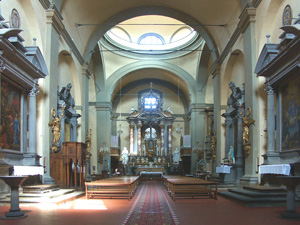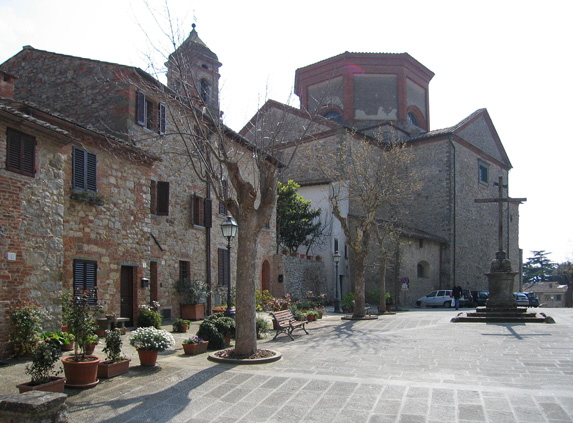Lucignano
The medieval walled village of Lucignano sits comfortably on top of a hill at 414 meters above sea level in southern Tuscany, half way between the major cities of Arezzo and Siena.
 Lucignano is remarkable for its singular layout, an elliptical plan with ramparts which enclose narrow streets that move in concentric circles. Lucignano is remarkable for its singular layout, an elliptical plan with ramparts which enclose narrow streets that move in concentric circles.
Strolling around the alleys may recall the experience of a labyrinth, finally solved once you arrive at the top of the village, where the Council Palace (formerly the Courthouse), the museum, the San Francesco and Collegiata Churches are.
Going into town from Porta San Giusto, one of the two main entrances, tuning right will lead you to Via Matteotti, la Via Ricca (the Road of the rich), worm and bright, overlooking south and the Valdichiana valley and thus chosen by the rich and noble families as their residence.
 Turning left will bring you instead to Via Roma, la Via Povera (the Road of the poor) with its little and essential houses, small doors and windows. This narrow road with the houses facing north is obviously colder and less comfortable in winter and was therefore occupied in ancient times by the poorer people. The four entrances and car parks all the way outside the town walls makes it extremely easy to walk into the historical centre, where a visit at the Collegiate and the San Francesco churches are recommended. Turning left will bring you instead to Via Roma, la Via Povera (the Road of the poor) with its little and essential houses, small doors and windows. This narrow road with the houses facing north is obviously colder and less comfortable in winter and was therefore occupied in ancient times by the poorer people. The four entrances and car parks all the way outside the town walls makes it extremely easy to walk into the historical centre, where a visit at the Collegiate and the San Francesco churches are recommended.
The main museum by the Council Palace hosts the Albero d’Oro or Albero dell’amore (The Golden Tree) which is must if you are visiting the Lucignano area. The Albero d’Oro is a beautiful and probably unique piece of jewellery of the shape of a tree, about 2 meters high, made of gold and silver with the 12 branches decorated with corals and crystals. The top part is decorated with a crucifix and a pelican that peaks his own chest to feed the cubs.
The tradition among lovers to promise love to each other in front of the Albero d’Oro is a very old one: you will find some Lucignanese ready to swear that a promise made in front of the Lucignano Golden Tree has always been kept. The least we can say is that it is had to believe it but the two Euros that is the cost of the entrance to the museum it is well worth a try! Whatever the case, it is a fact that the Golden Tree is a very popular destination among betrothed couples from all over the world, who come to Lucignano and make their promise in front of this touching symbol.
 The prominent and strategical position of Lucignano has turned this little village into an important fortress, quarrelled for centuries between the cities of Florence, Siena an Perugia and passing many times from one administration to the other. Under Siena in 1300 the fortification was ended, the surrounding walls were completed and the three entrance doors were built, together with the two watchtowers. The prominent and strategical position of Lucignano has turned this little village into an important fortress, quarrelled for centuries between the cities of Florence, Siena an Perugia and passing many times from one administration to the other. Under Siena in 1300 the fortification was ended, the surrounding walls were completed and the three entrance doors were built, together with the two watchtowers.
In 1554 Lucignano passed to the Medici family, the grand dukes of Tuscany, and important improvements were made. The building of a fort outside the walls was started, though it was never finished. The Church of Madonna della Querce outside the town centre (1568), the Monastery for the Frati Cappuccini (1580) the Church of Misericordia (1582) and the one that became the main Church, the Collegiate (1594) were built.
The Misericordia church
The Misericordia church is a tiny one and unique. Through a communicating door there is access to a room used in ancient times as a first aid hospital. Today it hosts a museum with the tools used at the time to assist wounded people and to bury remains. This museum is open on Sunday.
A curiosity: the Italian word misericordia means mercy. The Misericordia organizations were quite common in little villages like Lucignano; their main task was to provide first aid, cure people (with the tools and knowledge available at the time) and to bury the remains: it was an ancient form of hospital organization. In most cases the premises would host also a little church an this is the reason why the Misericordia churches are quite common in most Tuscan villages. Today the word misericordia is still commonly used to name organizations that provide assistance to less able people and elders, and who provide first aid in more remote areas. They are usually run by volunteers and financed by donations.
Lucignano is proudly keeping this tradition with its own Misericordia, well organized and most respected. The feeling to live in a community, where it is good to help others in sight of a possible future need, and for the well being of the entire community is still there like hundreds of years ago. And their work is still excellent.

Population: 3500
Local market: Thursday morning
|

